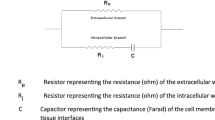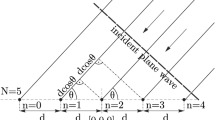Abstract
A digital wideband frequency-shift keying (FSK) demodulator is presented. The primary application of this system is for inductively powered biomedical implants. By providing both the data and the power to the implant via an inductive link, the need for a battery and the interconnect wires are eliminated. This reduces revision surgeries that may take place for maintenance purposes, provides extra safety measures in the case of failures and reduces the risk of infection. However these devices are challenged by power requirements and size availability at the receiving site and often require a high data rate. These challenges lead to the need for an efficient demodulation technique, as traditional methods often do not overcome the restrictions that prevail. The demodulator circuitry presented relies solely on delaying elements, utilising a delayed FSK carrier to sample the incoming FSK waveform. The system architecture is based on a digital environment and both the data and a synchronised clock are derived concurrently. This can be achieved with the coherent-FSK modulated raw binary data stream without the need of any additional baseband coding schemes. The demodulator circuitry was simulated up to a data rate of 5 Mbps while receiving a 5/10 MHz FSK carrier. The system was also implemented on the bench and experimentally tested at a data rate of 1.042 Mbps with no detectable bit error rate while receiving a 4.16/6.25 MHz FSK carrier signal.
Similar content being viewed by others
References
Margalit, E., et al.,Retinal prosthesis for the blind. Surv. Ophthalmol., 47: p. 335–356, 2002.
Frasson, M., et al.,Retinitis pigmentosa: rod photoreceptor rescue by a calcium-channel blocker in the rd mouse. Nat. Med, 10: p. 1183–1187, 1999.
Mohand-Said, S., et al.,Rod-cone interactions: developmental and clinical significance. Prog. Ret. Eye Res, 20: p. 451–467, 2001.
Sakamoto, T., Ikeda, Y. and Yonemitsu, Y.,Gene targeting to the retina. Adv. Drug Deliv, 52: p. 93–102, 2001.
Marg, E. and Dierssen, G.,Reported visual percepts from stimulation of the human brain with microelectrodes during therapeutic surgery. Confinia Neurologica, 26(2): p. 57–75, 1965.
Schmidt, E.M., et al.,Feasibility of a visual prosthesis for the blind based on intracortical microstimulation of the visual cortex. Brain, 119 (Pt 2): p. 507–522, 1996.
Dobelle, W.H.,Artificial vision for the blind by connecting a television camera to the visual cortex. American Society for Artificial Internal Organs, 46: p. 3–9, 2000.
Suaning, G.J. and L. N.H.,CMOS stimulation system with 100 electrodes and radio frequency telemetry, in Biomedical Engineering in Third Millenium, IEEE Engineering in Medicine and Biology Society (Victorian Chapter) 22nd–23rd Feb, Melbourne, Australia,, B. Lithgow and I.E. Cosic, Editors. p. 37–40, 1999.
Liu, W., et al.,A neuro-stimulus chip with telemetry unit for retinal prosthetic device. IEEE Journal of Solid-State Circuits, 35(10): p. 1487–1497, 2000.
Suaning, G.J. and Lovell, N.H.,CMOS neurostimulation ASIC with 100 channels, scaleable output, and bidirectional radiofrequency telemetry. IEEE Transactions On Bio-Medical Engineering, 48(2): p. 248–260, 2001.
Gerald, J.A.B., et al.,F-link for cortical neuroprosthesis. IEEE Circuits and Systems Magazine, 3: p. 2739–2742, 2005.
Ghovanloo, M. and Najafi, K.,A wideband frequency-shift keying wireless link for inductively powered biomedical implants. IEEE Transactions On Circuits and Systems, 51(12): p. 2374–2383, 2004.
Troyk, P.R. and DeMichele, G.A.,Inductively-Coupled Power and Data Link for Neural Prostheses using a Class-E Oscillator and FSK modulation. in Proceedings of the 25th Annual International Conference of the IEEE EMBS. Cancun, Mexico, 2003.
Dong, M., et al.,A Wideband Frequency-Shift Keying Demodulator for Wireless Neural Stimulation Microsystems. in Proceedings of the 19th Internationcal Conference on VLSI Design. 2006.
Suaning, G. J., et al.An Efficient Multiplexing Method for Addressing Large Numbers of Electrodes in a Visual Neuroprosthesis. in 26th Annual International Conference of the IEEE-EMBS. San Francisco, CA USA, 2004.
Cha, K., K.W. Horch, and R.A.Normann, Mobility performance with a pixelized vision system. Vision Research, 32(7): p. 1367–1372, 1992.
Author information
Authors and Affiliations
Corresponding author
Rights and permissions
About this article
Cite this article
Jung, L.H., Preston, P., Suaning, G.J. et al. A wideband frequency-shift keying demodulation technique for inductively powered biomedical implants. Australas. Phys. Eng. Sci. Med. 30, 141–146 (2007). https://doi.org/10.1007/BF03178419
Received:
Accepted:
Issue Date:
DOI: https://doi.org/10.1007/BF03178419




